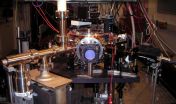(Press-News.org) Among high school students in Los Angeles, those who had ever used electronic cigarettes were more likely to report initiation of smokable ("combustible") tobacco (such as cigarettes, cigars, and hookah) use over the next year compared with nonusers, according to a study in the August 18 issue of JAMA.
Combustible tobacco, which has well-known health consequences, has long been the most common nicotine-delivering product used. Electronic cigarettes (e-cigarettes), which are devices that deliver inhaled aerosol usually containing nicotine, are becoming increasingly popular, particularly among adolescents, including teens who have never used combustible tobacco. According to 2014 U.S. estimates, 16 percent of 10th graders reported use of e-cigarettes within the past 30 days, of whom 43 percent reported never having tried combustible cigarettes. Whether use of e-cigarettes is associated with risk of initiating combustible tobacco use has not been known, according to background information in the article.
Adam M. Leventhal, Ph.D., of the Keck School of Medicine of the University of Southern California, Los Angeles, and colleagues examined whether adolescents who reported ever using e-cigarettes were more likely to initiate the use of combustible tobacco (cigarettes, cigars, and hookah) during the subsequent year. The study included 2,530 students from ten public high schools in Los Angeles who reported never using combustible tobacco at study entry (fall 2013, 9th grade, average age = 14 years) and completed follow-up assessments at 6 months (spring 2014, 9th grade) or 12 months (fall 2014, 10th grade). At each time point, students completed self-report surveys on any use of combustible tobacco products.
The researchers found that e-cigarette users (n = 222) were more likely than never users (n = 2,308) to report past 6-month use of any combustible tobacco product at the 6-month follow-up (31 percent vs 8 percent) and at the 12-month follow-up (25 percent vs 9 percent). Baseline e-cigarette use was associated with a greater likelihood of use of any combustible tobacco product averaged across the 2 follow-up periods in the analyses adjusted for sociodemographic, environmental, and intrapersonal risk factors for smoking. In addition, relative to baseline e-cigarette never users, e-cigarette ever users were more likely to be using at least 1 more combustible tobacco product averaged across the 2 follow-up assessments.
"These data provide new evidence that e-cigarette use is prospectively associated with increased risk of combustible tobacco use initiation during early adolescence. Associations were consistent across unadjusted and adjusted models, multiple tobacco product outcomes, and various sensitivity analyses," the authors write.
They add that "some teens may be more likely to use e-cigarettes prior to combustible tobacco because of beliefs that e-cigarettes are not harmful or addictive, youth-targeted marketing, availability of e-cigarettes in flavors attractive to youths, and ease of accessing e-cigarettes due to either an absence or inconsistent enforcement of restrictions against sales to minors."
"Further research is needed to understand whether this association may be causal."
(doi:10.1001/jama.2015.8950; Available pre-embargo to the media at http://media.jamanetwork.com)
Editor's Note: This research was supported by grants from the National Institutes of Health. The authors have completed and submitted the ICMJE Form for Disclosure of Potential Conflicts of Interest and none were reported.
Editorial: E-Cigarette Use and Subsequent Tobacco Use by Adolescents
The report by Leventhal and colleagues is the strongest evidence to date that e-cigarettes might pose a health hazard by encouraging adolescents to start smoking conventional tobacco products, writes Nancy A. Rigotti, M.D., of Massachusetts General Hospital and Harvard Medical School, Boston,
"Regardless of whether e-cigarettes are a gateway to tobacco product initiation, there is no reason for adolescents to use a product for which the hypothesized public health benefit is harm reduction for adult smokers. However, there is ample evidence that e-cigarettes are marketed in ways that appeal to children and adolescents. Prompt, effective action is needed to protect youth and reduce the demand for e-cigarettes by nonsmokers of all ages. A rational approach is to extend to e-cigarettes the same sales, marketing, and use restrictions that apply to combustible cigarettes."
(doi:10.1001/jama.2015.8382; Available pre-embargo to the media at http://media.jamanetwork.com)
Editor's Note: Please see the article for additional information, including financial disclosures, funding and support, etc.
Related Viewpoint: The Global Health Implications of e-Cigarettes
In an accompanying Viewpoint, Andrew Y. Chang, M.D., and Michele Barry, M.D., of the Stanford University School of Medicine, Stanford, Calif., discuss health considerations of e-cigarettes unique to low- and middle-income countries.
"Developing nations should not underestimate the availability and targeted marketing of electronic nicotine delivery systems (ENDS) within their borders and should place e-cigarettes under the purview of their medical and pharmaceutical regulatory boards. Low- and middle-income countries can feel empowered to exclude multinational tobacco companies from this regulatory process in accordance with Article 5.3 of WHO's Framework Convention on Tobacco Control, which warns against the conflict of interest posed by the industry in this sphere."
"International nongovernmental organizations such as the Gates Foundation and the Bloomberg Initiative to Reduce Tobacco Use should support these efforts to provide consistency in control and enforcement of ENDS legislation. Even though e-cigarettes may have a future as smoking cessation tools, evidence to support this indication is lacking. More rigorous studies must be conducted regarding the awareness, usage patterns, and potential for harm of these devices in low-income countries, particularly Africa and South Asia, where data are currently missing."
(doi:10.1001/jama.2015.8676; Available pre-embargo to the media at http://media.jamanetwork.com)
Editor's Note: The authors have completed and submitted the ICMJE Form for Disclosure of Potential Conflicts of Interest and none were reported.
INFORMATION:
Among overweight and obese patients with type 2 diabetes, daily injection of the diabetes drug liraglutide with a modified insulin pen device, in addition to diet and exercise, resulted in greater weight loss over 56 weeks compared with placebo, according to a study in the August 18 issue of JAMA.
Obesity is a chronic disease and a significant global health challenge. Weight loss is recommended for patients with type 2 diabetes. Moderate weight loss (5 percent-10 percent) can improve glycemic control and other cardiometabolic risk factors and disorders. Weight loss is ...
Among patients with active cancer and acute symptomatic venous thromboembolism (VTE; blood clots in the deep veins), the use of the low molecular-weight heparin tinzaparin daily for 6 months compared with warfarin did not significantly reduce recurrent VTE and was not associated with reductions in overall death or major bleeding, but was associated with a lower rate of clinically relevant nonmajor bleeding, according to a study in the August 18 issue of JAMA.
Venous thromboembolism is a major cause of illness and death in patients with cancer. Treatment with low-molecular-weight ...
Scientists from the University of Sheffield have discovered MRI scanners, normally used to produce images, can steer cell-based, tumour busting therapies to specific target sites in the body.
Magnetic resonance imaging (MRI) scanners have been used since the 1980s to take detailed images inside the body - helping doctors to make a medical diagnosis and investigate the staging of a disease.
An international team of researchers, led by Dr Munitta Muthana from the University of Sheffield's Department of Oncology, have now found MRI scanners can non-invasively steer cells, ...
Women giving birth after undergoing fertility treatment face an increased risk of depression compared to women ending up not having a child following fertility treatment, according to new research from the University of Copenhagen. According to the researchers, this has key implications for fertility treatment in future.
Danish researchers are among the first worldwide to study the risk of developing a clinical depression for women undergoing fertility treatment. The new study shows that women who give birth after receiving fertility treatment are five times more likely ...
Tropical Depression 11E came to an end early today, Tuesday, August 18 when the National Hurricane Center noted that the storm degenerated into a remnant low pressure area. NOAA's GOES-West satellite caught an infrared image of the fizzling system.
At 5 a.m. EDT (2 a.m. PDT/0900 UTC) the National Hurricane Center (NHC) issued the final bulletin on Post-Tropical depression 11E. At that time, the center of Post-Tropical cyclone 11E was located near latitude 24.9 North and longitude 125.6 West. It had fizzled about 1,000 miles (1,610 km) west of the southern tip of Baja ...
Researchers from Ludwig-Maximilians-Universitaet (LMU) in Munich have used computed microtomography (micro-CT) to identify to the species level an exceptionally wellpreserved fossil arthropod from the famous Chengjiang Lagerstätte in China.
Modern imaging methods make it possible to perform detailed, non-invasive studies on the internal structures of irreplaceable fossil specimens. Researchers led by Dr. Yu Liu of LMU's Department of Biology II now demonstrate the power of this approach by using computed microtomography (micro-CT) to investigate a specimen recovered ...
Researchers from the University of Southampton have demonstrated for the first time a new laser cooling method, based upon the interference of matter waves, that could be used to cool molecules.
Our ability to produce samples of ultra-cold atoms has revolutionised experimental atomic physics, giving us devices from atomic clocks (the core of GPS) and enabling a range of quantum devices, including the possibility of a quantum computer.
However, the current technique of cooling atoms down from room temperature to the ultra-cold regime using optical molasses (the preferential ...
Methylmercury, a toxic form of mercury that is readily absorbed from the gastro-intestinal tract and can cause in a variety of health issues, poses a significant threat to marine animals at the top of the food web. A new study confirms that Artic species of these animals have higher concentrations of methylmercury in their tissues compared with animals lower in the food web; however, it also shows similar trends in selenium, which could help play a protective role against the toxic effects of mercury.
"Methylmercury concentrations increased through the food web at greater ...
When a patient is in urgent need of a doctor for illness or injury, expecting that doctor to help is natural.
But a new study , published in Social Psychological and Personality Science, finds that the greater patients' need for medical care, the more likely patients will view their doctors as "empty vessels," devoid of emotions or personal lives of their own; at the same time, those patients expect their physicians to be able to contain the patients' emotions and experiences.
The study is unusual in that most research focuses on the reverse--how physicians view patients.
In ...
Students who have used electronic cigarettes by the time they start ninth grade are more likely than others to start smoking traditional cigarettes and other combustible tobacco products within the next year, according to a new study funded by the National Institutes of Health. E-cigarettes deliver nicotine to the lungs by heating a liquid solution that contains nicotine and other chemicals to produce an aerosol that the user inhales, a process often called "vaping."
The study compared tobacco use initiation among 222 students who had used e-cigarettes, but not combustible ...


